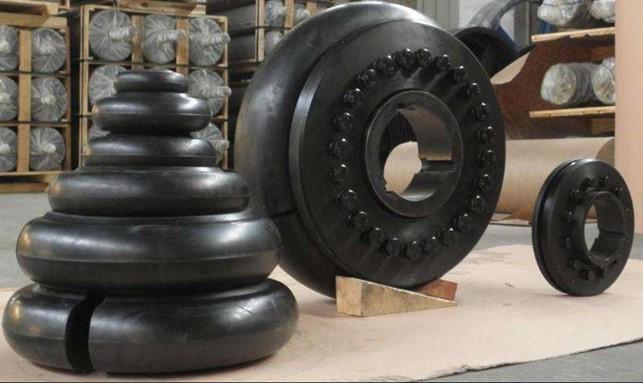
Tyre coupling
Advantage of UL model tire coupling rubber tyre coupling:
1. Easy to maintain, no need the tooled can install
2. Can undertake high torque
3. Have the good buffer
4. Flexibility, large damping, large compensation dosage
Design feature of UL model tire coupling rubber tyre coupling:
1. Plastic components( tyres) and metal plates made into a whole by sulfur and felting. Connecting the 2 half-coupling directly by bolts when installing.
2. Flexibility, large damping, large compensation dosage.
3. Simple designing ,easy for assembling and disassembling. The tyres can be replaced without moving 2 half-coupling.
4. Disadvantage, large axial power will be brought on the driven end as the rotate angle increasing.
Advantage of Hydraulic fluid coupling tyre coupling:
1. Easy to maintain, no need the tooled can install
2. Can undertake high torque
3. Have the good buffer
4. Flexibility, large damping, large compensation dosage
Design feature of Hydraulic fluid coupling tire coupling:
1. Plastic components( tyres) and metal plates made into a whole by sulfur and felting. Connecting the 2 half-coupling directly by bolts when installing.
2. Flexibility, large damping, large compensation dosage.
3. Simple designing ,easy for assembling and disassembling. The tyres can be replaced without moving 2 half-coupling.
4. Disadvantage, large axial power will be brought on the driven end as the rotate angle increasing.
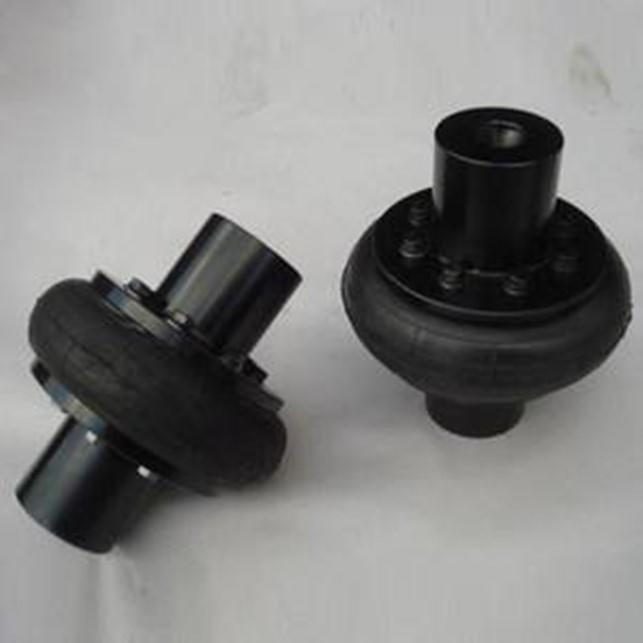
Tyre couplings are divided into two major categories: convex tire couplings and concave tire couplings. Convex tire couplings are divided into framed integral tyre couplings, boneless integral tire couplings and diameters. There are three types of incision type tire couplings. The inner side of the tire ring is bonded to the steel frame by a vulcanization method, and the bolt holes on the frame are welded with nuts. When assembling, bolts are used to connect the flanges of the two coupling halves, and the torque is transmitted by the friction generated between the tire and the flange end surface by tightening the bolts. The torsional shear deformation occurs when the tire ring is working, so the tire coupling It has a high elasticity, a large ability to compensate the relative displacement of the two shafts, and good damping, and the structure is simple, does not require lubrication, and is relatively convenient for assembly and disassembly and maintenance. The disadvantage is that the bearing capacity is not high and the overall size is large. As the relative torsion angle of the two shafts increases, the tire shape is distorted, and the axial size is slightly reduced, which will generate a large additional axial force on the two shafts. Increase bearing load and reduce life. When the tire coupling is running at high speed, the centrifugal force of the outer edge of the tire expands outward, which will further increase the additional axial force. For this reason, measures should be taken when installing the tire coupling to make the direction of stress in the tire opposite to the direction of stress generated during work to offset part of the additional axial force and improve the working conditions of the coupling and the two bearings.
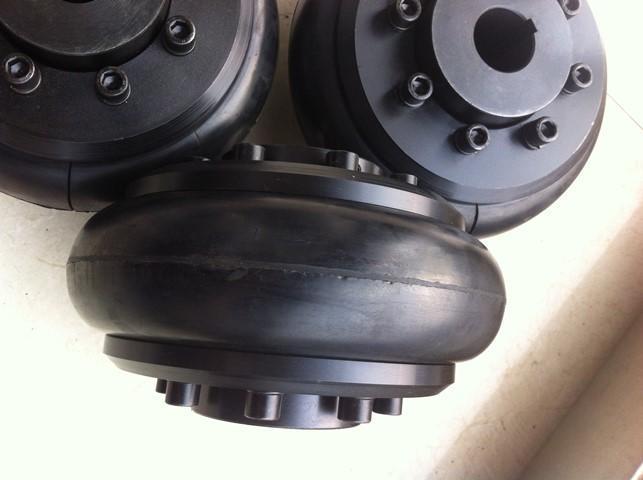
Tyre coupling classification:
1. LAK saddle-shaped elastic coupling is used to connect two coaxial transmission shafts. It has certain radial, axial and angular compensation and shock absorption performance. The ambient temperature is -20~+80℃, and the nominal torque transmitted is 63~50000N·m.
2. DL Polygonal Rubber Coupling Polygonal rubber coupling is made of rubber material, made into a circular 6-corner (or octagonal) elastic part, and it is embedded with rubber after vulcanization. The sleeves are connected with the half coupling flanges on the main and driven ends by using 6 (or 8) bolts passing through the sleeve. The polygonal rubber coupling is simple in structure, does not require lubrication, and is easy to assemble and disassemble. It can relax the torsional vibration and impact load of the drive shaft, prevent the drive shaft from resonating and compensate for the relative deviation of the two axes. It is suitable for medium torque 50 -8000N. M's light industry, construction machinery, mining machinery and other industries are suitable for working conditions with dust and moisture. The working temperature is -30-60C. It is used for the connection of vibrating screens and has significant effects.
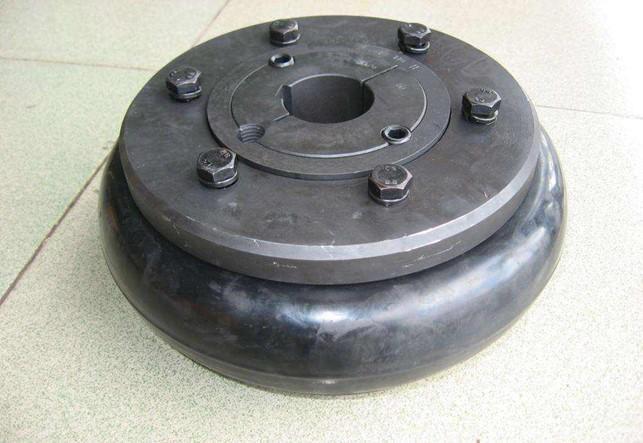
3. The LLA tyre coupling is a highly elastic coupling with good shock absorption and excellent inter-axis offset compensation performance. The operating temperature is -20~80 degrees Celsius, and the transmission torque is 10~20000N.M. It is suitable for wet, dusty, shock, vibration, variable forward and reverse and frequent starting working conditions. It is easy to disassemble and assemble without lubrication, and is durable and reliable.
4. LLB tyre coupling is a highly elastic coupling, with good shock absorption and excellent performance of offset compensation between axles, working temperature -20~80 degrees Celsius, transmission torque 10~20000N.M, The tire coupling is suitable for working conditions such as humidity, dust, shock, vibration, changeable forward and reverse rotation, and frequent starting. It is easy to disassemble and assemble because the elastic element is an integral tire body, which is convenient for disassembly and maintenance. Need to be lubricated, durable and reliable.
5. UL tyre coupling is a highly elastic coupling with good shock absorption and excellent inter-axis offset compensation performance. The working temperature is -20~80 degrees Celsius, and the transmission torque is 10~20000N.M. It is suitable for wet, dusty, shock, vibration, forward and reverse changing and frequent starting working conditions, and it is easy to disassemble and assemble, because the elastic element is an integral tire body, which is convenient for disassembly and maintenance without lubrication and durability. reliable.
UL type tyre coupling characteristics and applications: small torsional stiffness, strong damping capacity, large compensation, good damping, simple structure, no lubrication, easy assembly and disassembly and maintenance. Low noise, large radial size, low carrying capacity, and large axial additional load when overloaded. The service life depends on the quality of the rubber product. It is suitable for shaft transmissions with frequent starting, variable forward and reverse rotation, and large shock vibration. It can work under dust and moisture conditions, and is not suitable for high temperature, high torque and low speed and heavy load conditions.

Brief description:
The coupling is also called the coupling. A mechanical component used to firmly connect the driving shaft and the driven shaft in different mechanisms to rotate together and transmit motion and torque. Sometimes it is also used to connect shafts and other parts (such as gears, pulleys, etc.). It is often composed of two halves, which are connected by keys or tight fits, respectively, and fastened to the ends of the two shafts, and then the two halves are connected in some way. The coupling can also compensate for the deviation between the two shafts due to inaccurate manufacturing and installation, deformation or thermal expansion during work, etc. (including axial deviation, radial deviation, angular deviation or comprehensive deviation) ; And alleviate impact and absorb vibration.
Most of the commonly used couplings have been standardized or standardized. Under normal circumstances, it is only necessary to correctly select the type of coupling and determine the type and size of the coupling. When necessary, the load capacity of the vulnerable links can be checked and calculated; when the speed is high, the centrifugal force of the outer edge and the deformation of the elastic element need to be checked, and the balance check and so on.

Performance requirements:
According to different working conditions, the coupling must have the following performance:
(1) Mobility. The mobility of the coupling refers to the ability to compensate for the relative displacement of the two rotating components. Factors such as manufacturing and installation errors between the connected components, temperature changes during operation and load deformation, etc., all put forward requirements for portability. The movable performance compensates or relieves the additional load between shafts, bearings, couplings and other parts caused by the relative displacement between the rotating components.
(2) Cushioning. For occasions where the load starts or the working load changes, the coupling needs to have elastic elements that play a role in buffering and damping to protect the prime mover and the working machine from little or no damage.
(3) Safe and reliable, with sufficient strength and service life.
(4) Simple structure, convenient assembly, disassembly and maintenance.
Coupling selection:
1. Choose standard coupling. When choosing a coupling, the designer should first choose among the couplings that have been formulated as the national standard, the mechanical industry standard, and the national patent. Only when the existing standard couplings and patented couplings cannot meet the design needs Need to design the coupling by yourself.
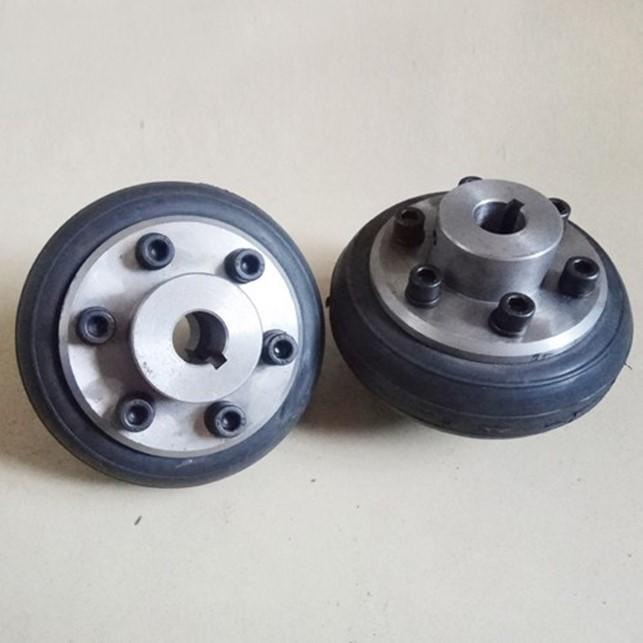
2. Select the type and type of coupling:
Understand the comprehensive function of the coupling (especially the flexible coupling) in the transmission system, and choose the type and type of the coupling from the overall design of the transmission system. According to the original idea type and working load type, working speed, transmission accuracy, two-axis offset condition, temperature, humidity, working environment and other comprehensive factors, choose the type of coupling. Select the structure of the coupling according to the needs of the supporting host. When the coupling is used with the brake, the coupling with brake wheel or brake disc should be selected; when overload protection is required, a safety coupling should be selected ; When connecting with flanges, the flange type should be selected; for long-distance transmission, when the axial size of the connection is large, it is appropriate to choose the intermediate shaft type or the intermediate sleeve type.
3. Calculation of coupling torque:
The power of the power machine in the transmission system should be greater than the power required by the work machine. According to the power and speed of the power machine, the high-speed theoretical short moment T connected to the power machine can be calculated; according to the working condition coefficient K and other related coefficients, the calculated torque Tc of the coupling can be calculated. The coupling T is inversely proportional to n, so the low-speed end T is greater than the high-speed end T.
4. Primary selection of coupling model:
According to the calculated torque Tc, the approximate nominal torque Tn can be selected from the standard series, and the selection should satisfy Tn≥Tc. The coupling model (specification) is preliminarily selected, and the allowable speed [n], the maximum radial dimension D and the axial dimension L0 of the coupling can be found from the standard, and the coupling speed n≤[n] .
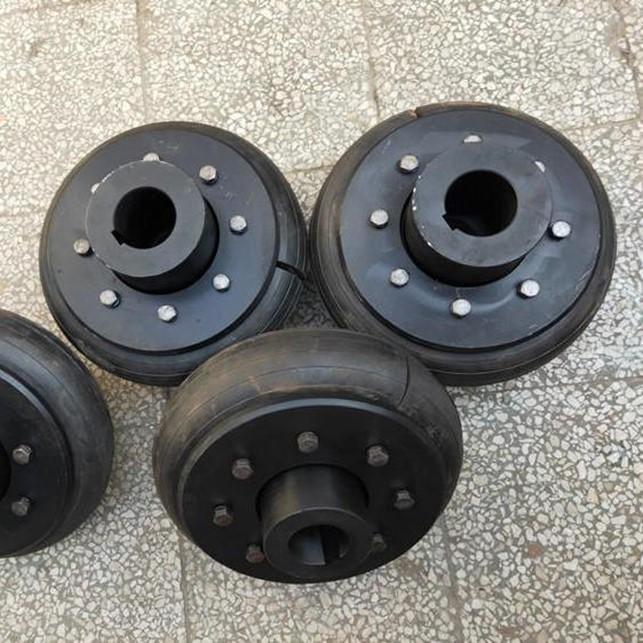
5. Adjust the model according to the shaft diameter:
The initially selected coupling size, that is, the diameter of the shaft hole d and the length of the shaft hole L, should meet the requirements of the shaft diameter of the driving and driven ends, otherwise the coupling specifications must be adjusted according to the shaft diameter d. It is a common phenomenon that the shaft diameters of the driving and driven ends are different. When the torque and speed are the same, and the shaft diameters of the driving and driven ends are different, the coupling model should be selected according to the larger shaft diameter. In the newly designed transmission system, the seven shaft hole types defined in GB/T3852 should be selected, and the J1 shaft hole type is recommended to improve versatility and interchangeability. The length of the shaft hole is based on the coupling product scale. Delineate.
6. Choose connection type:
The choice of coupling connection type depends on the connection type of the main and driven ends to the shaft. Generally, a key connection is adopted, which is the same key connection type and code. There are seven keyway types and four keyless types in GB/T3852. For connection, the A-type key is more commonly used.
7. Select the type, type and specification (model) of the coupling:
According to the comprehensive factors such as power machine and coupling load, speed, working environment, etc., select the coupling type; select the coupling type according to the coupling and connection conditions; according to the nominal torque and shaft hole Select specifications (models) for diameter and shaft hole length. In order to ensure the strength of the shaft and the key, after selecting the coupling model (specification), the strength of the shaft and the key should be checked to finally determine the coupling model.
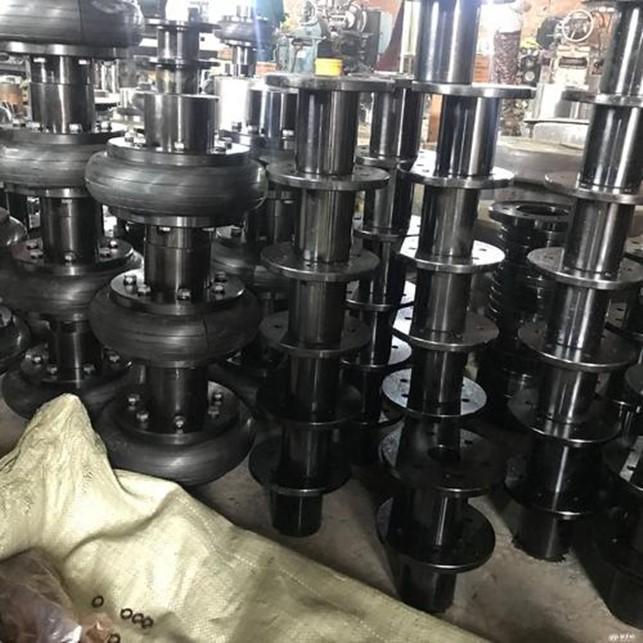

The best service from our transmission drive expert to your inbox directly.
Our Service
Get in Touch
Yantai Bonway Manufacturer Co.ltd
ANo.160 Changjiang Road, Yantai, Shandong, China(264006)
T+86 535 6330966
W+86 185 63806647